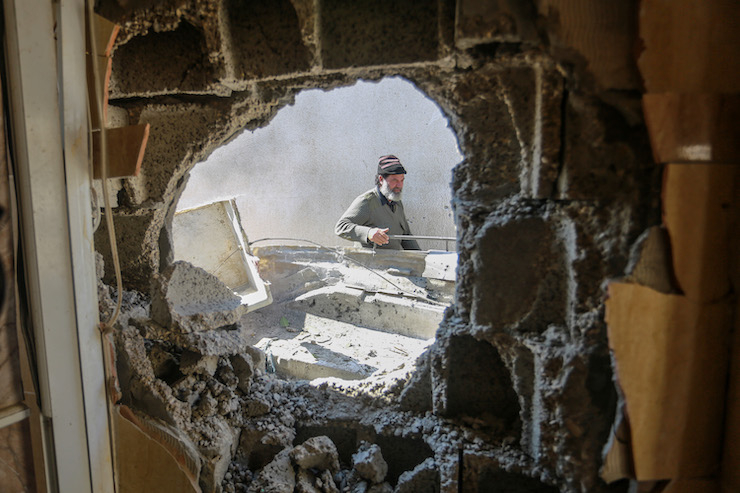Recent rockets fired into central Israel by armed groups in Gaza were not ‘mistakes,’ as both Hamas and Israel claim. The counter-intuitive context, Tareq Baconi explains, is a Hamas attempt to get Israel back onboard with a cease-fire agreement. Excerpts from The +972 Podcast.

Hamas and Israel reached a cease-fire agreement last November following months of Egyptian-mediated negotiations. Under that agreement, Israel was supposed to ease restrictions on the movement of people and goods in and out of Gaza. Hamas was supposed to curtail protests along the fence.
Tareq Baconi, Ramallah-based analyst for the International Crisis Group and author of “Hamas Contained: The Rise and Pacification of Palestinian Resistance,” believes that two rockets fired into central Israel by militants in Gaza in recent weeks were attempts by Hamas and other Palestinian factions “to pressure Israel into meeting its obligations under that cease-fire agreement” and adopt a more sustainable policy toward Gaza.
The Gaza Strip is facing an unprecedented crisis, Baconi explained on The +972 Podcast. In addition to the humanitarian and economic crises created by Israel’s 12-year blockade, the Palestinian Authority has stopped paying tens of thousands of Gazans their salaries and pensions.
>> Subscribe to the podcast: iTunes/Apple Podcasts | Google Play | Spotify <<
Furthermore, the staggering number of Palestinians killed and maimed during a year of the Great March of Return protests has had its own impact on the health system and economy. Many in Gaza, Baconi said, “would tell you they have nothing to lose.”
Indeed, the Great Return March and the recent flare up are connected, according to Baconi.
Below are excerpts of the interview, which can be heard in full on The +972 Podcast. Look for us on iTunes or wherever you get your podcasts.
“From day one, before the protests had even been initiated, [Israel] adopted an open fire and live fire policy against these civilians at staggering cost in terms of the loss of human life. But what that means as well is that popular mobilization on its own failed to compel Israel to revisit its blockade or its policies of isolation and failed to compel the international community to bring pressure on Israel to deal with the Gaza Strip differently.”
“In other words, the lesson that came out of the Gaza Strip was that only force works. Only when Hamas got involved was there an opening to start talking in terms of cease-fire negotiations and to bring more pressure on Israel. Only when the protests appeared to be more destructive and more intense to the peripheral communities within Israel did Israel respond.”
It’s interesting that once civil society took matters into its own hands, the way to ease the blockade again was to put the Great March of Return protests under Hamas’ wing. It sort of keeps control with Hamas.
“This is the biggest tragedy of the Great March of Return. It was very much a movement that was inspiring when it started and I think Palestinians — not just in the Gaza Strip, but everywhere — are talking about shifting to a rights-based struggle. They’re talking about shifting their struggle to an anti-apartheid struggle, to one that demands equality and freedom across the land, from the river to the sea.”
“The Gaza Strip, and what’s been happening over the course of the past year, shows how treacherous that path is. It shows how worrying it is for Palestinians to mobilize on the grassroots level because they face unprecedented challenges. They face challenges from Israel […] that has no qualms killing and firing at civilians who are engaged in popular protests, but you also see internal challenges where Palestinian factions co-opt and mobilize for their own factional interests.”
“There’s a real question here for Palestinians — for Palestinians who believe in civil disobedience and popular protests but who also do not believe in armed struggle, and do not believe in firing rockets at civilian populations in Israel. There’s a real question as to how to disrupt life in Israel in a way that allows for their demands to be heard without allowing their protests to be quashed.”
We’re also seeing internal divisions, both with Hamas and the Palestinian Authority, but also between Hamas and Islamic Jihad. Is the recent flare-up, the rocket that was fired last Monday, connected to Hamas’ ability to control other factions as well?
“I do not think this rocket fire […] was a result of those complications. I do think that there were many reasons that this specific rocket was fired. The broader reason is the cease-fire discussions, and this is Hamas’ way of trying to compel Israel to meet its cease-fire obligations before the election.”
“[Hamas] believes that the [Netanyahu government] isn’t going to escalate before the elections. So it believes that this is its best shot to force some kind of concession before the elections. But there are more immediate factors,” Baconi added, mentioning disturbances and Israeli measures against Palestinian prisoners inside Israel, tensions on the Temple Mount/Haram al-Sharif, as well as the Israeli army’s expanded incursions in the West Bank.
It has been said that these rockets were accidentally fired. Can you shed light on some of what’s happening there?
“In terms of the two rockets that were fired on March 14, the narrative that came out of that incident was that the rockets were fired by mistake. That was the story that Hamas leaders gave the Egyptian delegation that happened to be in the Gaza Strip on the day of the rocket fire. And that was also the story that was put forward by Israel’s own security establishment.”
“But I don’t believe the story that the rockets were fired by mistake. This narrative allows Hamas to claim that it still is abiding by its policy of not firing rockets and [it gives] Israel leeway to not respond in force or through a major escalation. But at the same time, it is a demonstration of Hamas’ willingness and capacity to fire rockets if Israel doesn’t meet its obligations under the cease-fire.”
“So it’s basically a fig leaf that allows both parties to pretend that they’re still interested in averting an escalation, but also reminding the other that they could go toward an escalation if the cease-fire doesn’t hold.”
The Trump administration this week recognized the Golan Heights as Israeli territory. It also recently committed to more humanitarian aid for Gaza. How does this affect everything that’s going on?
“The way the Trump Administration is dealing with the question of Palestine is somehow paradoxical because on the one hand you hear about the administration wanting to alleviate humanitarian suffering in the Gaza Strip, and on the other hand you see them defunding UNRWA, which in many instances is a matter of life and death for Palestinians in Gaza.”
“So what’s clear in the Trump policies is that there is an effort to de-politicize the Palestinian question. Money is taken away from UNRWA in order to redefine who and what a Palestinian refugee is, and money is injected into the Gaza Strip, or planned to be injected into the Gaza Strip, to fund infrastructure projects or to fund economic development.”
“The Gaza Strip is suffering because it’s under blockade; it’s under blockade because of a political decision by Israeli governments to maintain the segregation of two million Palestinians, away from Israeli control. That decision is a political decision. The Gaza Strip is not an economic challenge to be resolved. The situation of the Gaza Strip, as in the West Bank and East Jerusalem, won’t be alleviated until Palestinian political rights are addressed.”

